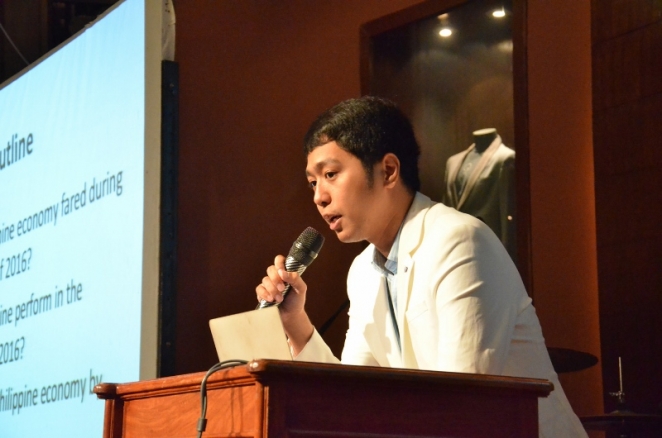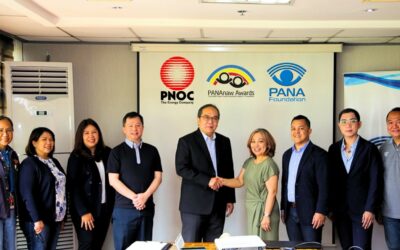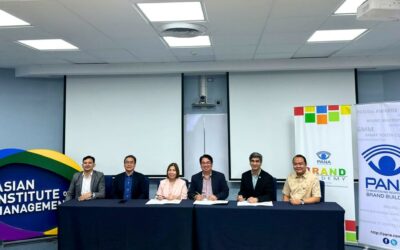
Currently with the Asian Institute of Management’s Dr. Andrew L. Tan Center for Tourism, Dr. Rivera serves as the Managing Editor of the Asia Pacific Business and Economics Perspectives based in Japan. Serving the academe, he held stints as Associate Professor at the School of Economics of De La Salle University.
Growth, and The Philippines
The country is growing at a steady pace, from 6.2% in October 2015, to 6.5% in January 2016, to 6.9 in April—to hit beyond 7.5% by October 2016 sans adverse force, or force majeure.
Among the thought points Dr. Rivera discussed was the elusive inclusive growth. Elusive perhaps because, as the speaker pointed out, “Does inclusive growth only gauge through expenses? The Philippine economy is consumption-driven, that is more from household at 4.9 points versus government at only 1.0 points. The more people consume, the more it helps the economy.”
He further advised, “For the advertisers, it may be that if you advertise more, the more you can engage people into spending/consuming.”
First Quarter 2016 GDP stands at 6.9–with Industry at 2.9, and Services at 4.4—contributing to growth. Agriculture is at a dismal -0.4. As it is the socio-economic trigger of food basins of Southeast Asia, agriculture—its development—is all too important to the progress of the country. Agriculture, and the losses to this land-to-belly sector, is directly proportional to the gains of the Services sector.
The reason? The Philippines is moving into industry and services. The country is removing itself from agriculture. However, Rivera is quick to point that, “The Services sector still growing, but services are still not delivered. This means that there is still more space in the BPO industry, there’s still the need to hire more people.”
According to Rivera, it is all too important for agriculture to grow, just like manufacturing because the country cannot forever rely on its Overseas Foreign Workers (OFWs) and Business Processing and Outsourcing (BPO). “That’s not our core competency. Our core competency is in agriculture,” stressed Rivera.
To recap, the country’s Services sector is growing much faster than manufacturing, but as a young economy, manufacturing must grow faster than services because manufacturing is the source of exports.
So what is the change expected with the newly-elected and inducted government? Back to inclusive growth, and with it comes an imperative for government to spend. “With the Duterte administration, the plan is to increase government spending. This must come from government infrastructure development,” Rivera shared.
ASEAN: The Philippines and its neighbors
The looming ASEAN integration is nudging the country to continue growing, surely, but currently, the Philippines is only at par with Vietnam in terms of competitiveness. Rivera would want the country, in fact, to be chasing the rate of Malaysia and Thailand, currently at 2nd and 3rd, respectively, where both countries have been investing heavily on infrastructure. Singapore is ranked 1st.
Again, it is that word: Infrastructure. And, here is where Rivera addressed the Real Estate industry to be alert and ready. The ASEAN integration brings with it free movement of products, services and labor. People of the region will be free to move across ASEAN countries, and therefore there will be a need to house people, to provide lodgings and shelter.
Asked how the country can sustain growth, Rivera offered that the answer lies in foreign investment. “You let foreign direct investment enter. But FDI needs confidence, and requires good governance,” he replied.
In his talk, Rivera shared how the current administration is enjoying a very high 91% trust rating, the likes not seen before. Infrastructure is a priority—and it is not easy to build. For instance, the proposed Mindanao railway will cost the government, but is necessary to push development outside of the capital. Rivera further advised that the foreign exchange would spike to US$ 1 to PhP48 by 2017 as a result of the massive spending by government on infrastructure.
Another element that can sustain business confidence to spike in 2017 is speed of transaction. Where the Philippines is targeting a 3-day wait for business permits approval, Singapore already enjoys approval in 1 day.
By and large, The Philippines is smack center at No. 5 of the most competitive of the 10 ASEAN countries. But the glaring country of envy must be Vietnam that is at No. 4. Oh, and by the way, PH is also the 5th most corrupt in the ASEAN. “Investors would rather invest in Thailand, Malaysia, Indonesia,” shared Rivera.
It’s more fun in The Philippines
There must be something right with the DoT’s slogan, as the tourists did come. Rivera, in fact, forecasted that tourism would continue to grow in the next year. In tandem with this growth, locals will also go around the country before they will try other countries. However, the speaker insisted that the country was ill-equipped to accommodate the numbers. “We were not ready with the infrastructure, transportation, services and hospitality, etc. That’s why with the current administration, infrastructure is the priority. We must first perfect our products first before creating new ones,” said Rivera.
by: Aye P Ubaldo
[nggallery id=512]



